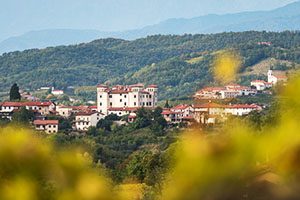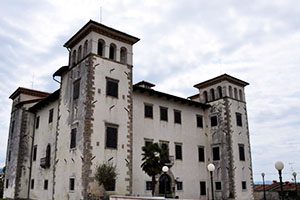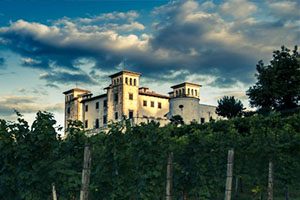


Na Dobrovem je že od 13. stoletja dalje stal grad, ki pa je v stoletjih propadal. Na njegovem mestu je na začetku 17. stoletja zraslo novo renesančno grajsko poslopje, ki se je ohranilo v razmeroma nespremenjenem videzu in velja danes za eno najlepših na Goriškem. Dobrovska graščina je v tlorisu skoraj pravilen kvadrat s simetrično postavljenimi stolpi na vogalih. Obzidje je bilo verjetno postavljeno med drugo beneško vojno (1615-1617) in po končani nevarnosti spremenjeno v arkadni hodnik, eden od stolpov pa v kapelo, posvečeno sv. Antonu Padovanskemu. Stene kapele krasijo sneti originali in kopije gotskih fresk z ozemlja severne Primorske.
V prvem nadstropju graščine obiskovalca pričaka Viteška dvorana z grbi nekaterih plemiških družin, ki so imele grad v posesti. V dvorani je ohranjena stenska poslikava s prizorom pomorskega napada na mesto. Danes Viteška dvorana gosti številne glasbene in druge prireditve. Zanimiva je tudi Lovska soba, kjer so prikazane posesti grofa Baguerja, ki jih je leta 1894 na stene poslikal Clemente Del Neri. Njegove umetnine lahko občudujemo tudi na stopnišču.
Muzejske prostore v 1. nadstropju bogati kulturno-zgodovinska zbirka, ki predstavlja družino ter muzejsko zbirko grofa Silverija de Baguer. V drugem nadstropju, spremenjenem v galerijo, pa si lahko ogledate največjo evropsko zbirko grafičnih del briškega rojaka, svetovnega znanega umetnika, Zorana Mušiča. Občasno organizirajo tudi druge razstave.
V viteški dvorani ter na razkošnem dvorišču se odvijajo kulturne prireditve ter poroke. V pritličju in kamnito obokani kleti nudijo grajsko kosilo in pokušino vina.
Brda - Schloß Dobrovo
Seit dem 13. Jahrhundert stand auf Dobrovo das Schloss, das jedoch im Lauf der Jahrhunderte verfiel. An jener Stelle begann zu Beginn des 17. Jahrhunderts ein neues Renaissanceschlossgebäude zu entstehen, das in relativ unveränderter Form erhalten geblieben ist und heute zu den schönsten Schlössern in der Region Goriška zählt. Der Gutshof Dobrovo ist im Grundriss fast ein Quadrat mit symmetrisch an den Ecken angeordneten Türmen. Das Gemäuer wurde vermutlich während des zweiten Venezianischen Krieges (1615-1617) errichtet und nach Ende der Bedrohung in einen Arkadengang und einer der Türme in eine Kapelle umgewandelt, die dem hl. Anton von Padua geweiht wurde. Die Wände der Kapelle sind mit Originalen und Kopien gotischer Fresken aus der nördlichen Region der Primorska geschmückt.
Im ersten Stock des Herrenhauses erwartet den Besucher der Rittersaal mit den Wappen mehrerer Adelsfamilien, die die Burg in Besitz hatten. In der Halle gibt es Wandmalereien mit der Szene eines Marineangriffs auf die Stadt. Heute beherbergt der Rittersaal zahlreiche Musik- und andere Veranstaltungen. Interessant ist auch das Jagdhaus, in dem die Besitztümer des Grafen Baguer ausgestellt sind, die 1894 von Clemente Del Neri an die Wände gemalt wurden. Seine Kunstwerke können auch im Treppenbereich bewundert werden.
Die Museumsräume im 1. Stock sind eine reiche kulturhistorische Sammlung, die die Familie sowie die Museumssammlung des Grafen Silbrig de Baguer darstellt. Im zweiten Stock, der in eine Gallerie umgewandelt wurde, können sie die größte europäische Sammlung grafischer Werke des weltberühmten Görzer Künstlers Zoran Mušič sehen. Gelegentlich werden aber auch andere Ausstellungen dargeboten.
Im Rittersaal und dem üppigen Innenhof finden kulturelle Veranstaltungen und Hochzeiten statt. Im Erdgeschoss und im Keller mit Steingewölbe werden Ritteressen und Weinverköstigungen geboten.
Brda - the Castle Dobrovo
At Dobrovo there has been a castle already from the 13th century onwards, which however fell to ruins in the course of centuries. On its place a new renaissance castle building was erected, which is preserved in a relatively unchanged shape and is known as one of the most beautiful in the Goriška region. The Dobrovo castle is in layout in almost regular square form with symmetrically built towers on the corners. The walls were probably built during the second Venezian war (1615-1617 ) and were after its termination changed to arcadic corridor and one of the towers to a chappel, dedicated to Saint Anthony from Padua. The walls of the chappel are decorated with collected originals and copies of gothic frescoes from the Northern Primorska region.
In the first floor of the castle the visitors can admire the Hall of Knights with the coat of arms of some noble families, which possessed the castle. In the hall there is a wall painting preserved with the scene of the naval attack of the town. Today this hall guests numerous musical and other events. Very interesting is also the Hunter’s room, where the properties of the Count Baguer are shown, which were painted on the walls in 1894 by the artist Clemente Del Neri. We can admire his masterpieces also on the staircase.
The museum rooms in the first floor are enriched by the cultural-historical collection, which is showing the museum collection of the Count Silveri de Baguer. In the second floor, converted to a gallery, the visitor can admire the biggest European collection of the graphical works of in Brda born, world renowned artist, Zoran Mušič. From time to time also other exhibitions are held there.
In the Hall of Knights and on the magnificient court cultural events and weddings are organized. In the basement and the stone arched cellar the castle lunch and wine tastings can be enjoyed.
